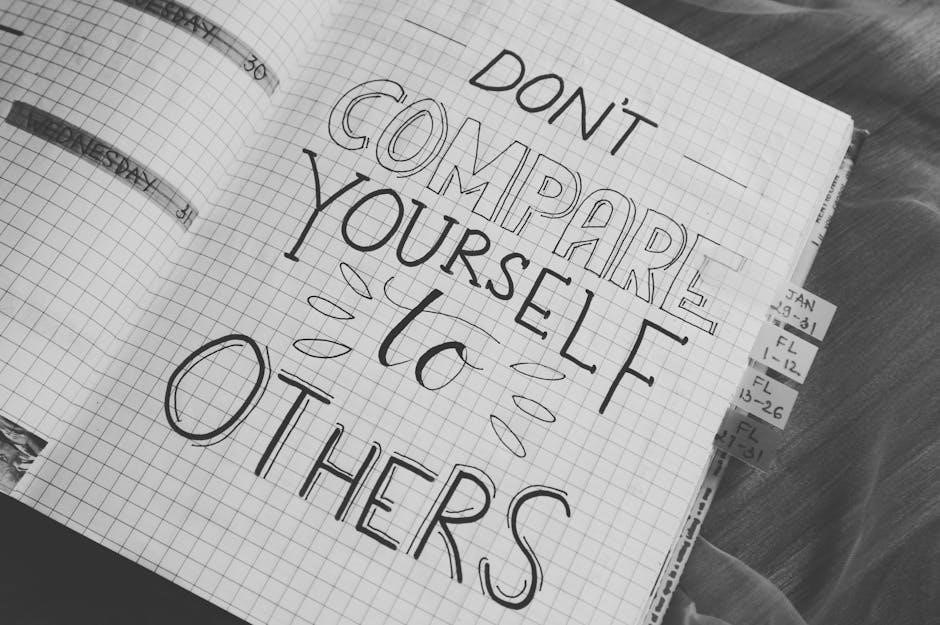compare and contrast graphic organizer pdf

Compare and contrast graphic organizers are visual tools designed to help users structure and analyze similarities and differences between concepts, ideas, or objects. These organizers, available in PDF formats, provide structured layouts like Venn diagrams, charts, and matrices, making it easier to identify and compare elements. They are widely used in educational settings to support learning, critical thinking, and effective organization of information for essays, presentations, and studies.
Definition and Purpose
A compare and contrast graphic organizer is a visual tool designed to help users systematically identify and analyze similarities and differences between concepts, ideas, or objects. These organizers, often available in PDF formats, provide structured layouts such as Venn diagrams, charts, and matrices. Their primary purpose is to enhance understanding by visually organizing information, making it easier to compare and contrast elements effectively. They are widely used in educational settings to support critical thinking, writing, and problem-solving activities, helping individuals structure their thoughts and ideas coherently.
Importance in Educational Settings
Compare and contrast graphic organizers are invaluable in educational settings as they enhance students’ ability to structure and organize information. They promote visual learning, making complex concepts easier to understand and retain. By highlighting similarities and differences, these tools foster critical thinking and analytical skills. They are particularly useful for teaching comparative essays, literary analysis, and scientific comparisons. Educators use them to engage students, simplify lesson planning, and assess understanding. These organizers are versatile, benefiting learners at all educational levels, from elementary to higher education, and across various subjects, including literature, history, and science.

Types of Compare and Contrast Graphic Organizers
Common types include Venn Diagrams, Double Bubble Maps, Carroll Diagrams, Two-Column Charts, and Compare-Contrast Matrices. Each serves unique educational purposes, enhancing visual and structured comparisons.
Venn Diagrams
Venn Diagrams are circular charts with overlapping sections, ideal for visually comparing and contrasting two or more concepts. They help identify similarities, differences, and overlaps, making complex relationships clear. Widely used in education, Venn Diagrams enhance critical thinking and organization skills; Their visual nature aids students in structuring ideas effectively. Available as PDFs, they are easily printable and customizable for various subjects. Teachers often use them to help students visualize comparisons, making learning engaging and interactive. This tool is especially beneficial for younger learners, as it simplifies abstract concepts into a digestible format, fostering deeper understanding and retention.
Double Bubble Maps
Double Bubble Maps are a dynamic graphic organizer used to compare and contrast two concepts visually. They consist of two main bubbles, each representing a concept, with smaller bubbles branching out to list attributes. The overlapping area highlights similarities, while unique features are placed in separate sections. This tool enhances critical thinking by visually organizing information, making it easier to identify relationships. Available as PDFs, they are easily customizable and ideal for various subjects. Teachers find them particularly effective for engaging students and helping them structure ideas clearly, fostering deeper understanding and retention of material.
Carroll Diagrams
Carroll Diagrams, also known as Carroll charts, are graphic organizers used to compare and contrast items based on specific attributes. They consist of a grid with rows and columns, where each row represents an item and each column represents a category or feature. Students place checkmarks or notes in the cells to indicate the presence or absence of a feature. This tool is particularly effective for analyzing similarities and differences in subjects like history or literature. Available as PDFs, Carroll Diagrams are versatile and easy to customize, making them a valuable resource for structured comparison activities in educational settings.
Two-Column Charts
Two-Column Charts are simple yet effective graphic organizers designed to help students compare and contrast two subjects. Each chart features two columns, one for each subject, with rows for listing specific attributes, features, or details. This side-by-side layout makes it easy to identify similarities and differences. Available in PDF formats, these charts are ideal for classroom use, homework, or independent study. They promote clear and organized thinking, making them a versatile tool for various subjects, including literature, science, and history. Their straightforward design ensures students can focus on analyzing and understanding the key aspects of their comparisons.
Compare-Contrast Matrices
Compare-Contrast Matrices are advanced graphic organizers that enable detailed comparisons of multiple subjects across various criteria. These matrices are particularly useful for analyzing three or more topics, with rows representing different attributes or features and columns dedicated to each subject. PDF versions of these matrices are widely available, offering a structured format for organizing information. They are ideal for complex comparisons in subjects like literature, science, or social studies. The matrix design promotes deeper analysis and helps students identify patterns, similarities, and differences systematically. Their versatility and clarity make them a valuable resource for both teachers and students.

How to Use a Compare and Contrast Graphic Organizer
Select topics to compare, identify criteria, and fill in the organizer systematically; Analyze similarities and differences visually to enhance understanding and organization of information effectively.
Step-by-Step Guide
Identify the two topics to compare and contrast.
Brainstorm key characteristics or features of each topic.
Use the graphic organizer PDF to list similarities and differences.
Fill in each section systematically, ensuring clarity.
Analyze the completed organizer to draw conclusions.
Review and refine your work for accuracy.
This structured approach helps organize thoughts and visually highlight comparisons, making complex analyses easier to understand and present.
Best Practices for Effective Use
To maximize the effectiveness of a compare and contrast graphic organizer PDF, start by setting clear objectives for the comparison. Simplify complex topics by focusing on key attributes. Use visuals like colors or symbols to highlight differences and similarities. Encourage critical thinking by asking open-ended questions. Provide examples to guide students, especially for younger learners. Regularly review and discuss completed organizers to reinforce understanding. By integrating these practices, educators can ensure the tool enhances learning outcomes and fosters deeper comprehension of the material.

Downloading and Printing Compare and Contrast Graphic Organizers
Download compare and contrast graphic organizers as PDFs from educational websites or marketplaces. Ensure the format matches your needs, such as A4 size for easy printing.
Popular Formats and Sizes
Compare and contrast graphic organizers are widely available in PDF format, offering versatility for educational needs. Common sizes include A4, Letter, and Legal, ensuring compatibility with standard printers. Many templates are designed with a clean, user-friendly layout, featuring ample space for notes and comparisons. Popular formats often include pre-designed Venn diagrams, double bubble maps, and two-column charts. PDFs are preferred for their scalability, maintaining clarity when enlarged or reduced. Teachers and students can easily customize these organizers to fit specific topics or activities. Selecting the right size and format ensures readability and practicality for both classroom and independent use.
How to Save and Print PDFs
Saving and printing compare and contrast graphic organizer PDFs is straightforward. First, download the PDF by clicking the “Download” button or right-clicking and selecting “Save as.” Ensure you have a PDF reader installed, such as Adobe Acrobat. Open the file, select “Print” from the menu, and choose your printer. Adjust settings like paper size, orientation, and quality if needed. Most organizers are designed for standard 8.5×11-inch paper. Print in black and white or color, depending on the template. Always preview the layout to ensure clarity. This process ensures your organizer is ready for immediate use in classrooms or personal study.

Benefits of Using PDF Versions
PDF versions offer consistent formatting, easy accessibility, and compatibility across devices. They maintain visual clarity, ensuring the graphic organizer’s structure remains intact for effective learning and analysis.
Convenience and Accessibility
Compare and contrast graphic organizer PDFs are highly convenient, offering easy access and portability across various devices. Students and educators can download them once and use them repeatedly without internet connectivity. PDFs are universally compatible, ensuring they can be opened on computers, tablets, and smartphones. Their digital format allows for quick sharing via email or cloud platforms, making collaboration seamless. Additionally, PDFs maintain consistent formatting, preserving the structure and clarity of the graphic organizer. This accessibility ensures that learning tools are readily available, fostering an efficient and flexible educational experience for all users.
Customization Options
Compare and contrast graphic organizer PDFs often come with editable features, allowing educators and students to tailor them to specific needs. Users can modify labels, add sections, or adjust layouts to suit different topics or grade levels. Some PDFs include fillable fields, enabling easy input of information without altering the document’s structure. Additionally, certain tools allow for color changes or font adjustments, enhancing visual appeal and engagement. These customization options make the organizers versatile and adaptable, ensuring they meet diverse educational requirements effectively. This flexibility enhances their utility in various learning environments and activities.

How to Choose the Right Graphic Organizer
Selecting the right graphic organizer involves assessing learning goals, student needs, and content complexity. Match the organizer’s structure to the task’s requirements for optimal effectiveness.
Evaluating Needs and Objectives
Evaluating needs and objectives is crucial when selecting a compare and contrast graphic organizer. Begin by identifying the learning goals and the complexity of the topic. Assess the age and skill level of the students to ensure the organizer is appropriate. Consider whether the task requires a simple or detailed comparison. Align the organizer’s structure with the specific objectives, such as highlighting similarities, differences, or both. For visual learners, tools like Venn diagrams or double bubble maps may be ideal, while two-column charts suit more structured comparisons. Customization options should also be evaluated to meet diverse needs effectively.
- Align the organizer with learning goals and objectives.
- Assess the complexity of the topic and students’ skill levels.
- Choose a format that matches the task’s requirements.
- Ensure the organizer is adaptable to different learning styles.
By evaluating these factors, educators can select the most effective tool for fostering understanding and engagement.
Matching Organizers to Learning Goals
Matching compare and contrast graphic organizers to learning goals ensures effective instruction. For instance, if the objective is to identify similarities and differences, Venn diagrams or two-column charts are ideal. For analyzing relationships between concepts, double bubble maps or Carroll diagrams are more suitable. When teaching critical thinking, compare-contrast matrices can help students evaluate multiple criteria. Aligning the organizer with specific learning outcomes enhances focus and engagement. By selecting tools that mirror the lesson’s objectives, educators can better guide students in achieving desired learning outcomes and developing deeper understanding of the material;
- Use Venn diagrams for visualizing relationships and overlaps.
- Apply two-column charts for straightforward comparisons.
- Utilize double bubble maps for hierarchical relationships;
This alignment ensures the organizer supports the lesson’s intended outcomes effectively.

Using Graphic Organizers in the Classroom
Graphic organizers enhance classroom engagement by structuring information visually. They aid group discussions, comparing texts, and analyzing ideas. Their versatility meets diverse learning needs, fostering concept mastery effectively.
Classroom Activities and Exercises
Classrooms can integrate compare and contrast graphic organizers through group comparisons of historical events, literary characters, or scientific concepts. Interactive activities like think-pair-share encourage students to discuss findings. Hands-on exercises involve creating Venn diagrams or double bubble maps to compare topics. Teachers can assign collaborative projects where students research and present comparisons using organizers. Technology integration allows students to create digital versions and share with peers. These activities promote critical thinking, collaboration, and effective communication, making learning interactive and engaging for all students.
Integrating with Lesson Plans
Compare and contrast graphic organizers can seamlessly integrate into lesson plans across subjects. Teachers can incorporate them into reading comprehension by analyzing characters or themes. In science, they can compare species or ecosystems. Math lessons can benefit by contrasting problem-solving strategies. Organizers align with learning objectives, reinforcing key concepts. They can be adapted to different grade levels and subjects, making them versatile tools. By embedding them into daily instruction, educators create structured opportunities for students to engage deeply with content, fostering meaningful connections and deeper understanding.

Graphic Organizers for Independent Study
Graphic organizers are valuable for independent study, aiding students in structuring homework, self-study, and personal projects. They help organize information, compare ideas, and retain knowledge effectively.
Homework and Self-Study Applications
Compare and contrast graphic organizers are excellent tools for homework and self-study, helping students structure their thoughts and analyze information effectively. They enable learners to break down complex assignments into manageable parts, organize notes, and visually compare concepts. For self-study, these organizers enhance understanding by highlighting relationships and differences between ideas. Students can use them to prepare for exams, write essays, or review course material independently. The clear, visual format promotes better retention and independent learning, making them ideal for homework and personal academic projects. PDF versions are particularly convenient for printing and using at home.
Enhancing Personal Learning
Compare and contrast graphic organizers are powerful tools for enhancing personal learning, fostering deeper understanding and critical thinking. By visually mapping out relationships and differences, learners can engage with material more actively, leading to better retention. These organizers help identify patterns, strengths, and weaknesses, making complex concepts more accessible. For independent learners, they provide a structured yet flexible way to explore topics, promoting self-directed growth and intellectual curiosity. Regular use enhances analytical skills, empowering individuals to approach challenges with clarity and confidence, whether in academics or personal development.

How Graphic Organizers Improve Learning Outcomes
Graphic organizers enhance understanding by visually structuring information, improving retention and the ability to apply knowledge. They reveal relationships and patterns, fostering better academic performance and deeper comprehension.
Enhancing Critical Thinking Skills
Compare and contrast graphic organizers are powerful tools for fostering critical thinking. By requiring learners to analyze similarities and differences, these organizers help students evaluate information systematically. They encourage the identification of patterns, relationships, and nuances, promoting deeper understanding. Visualizing concepts side by side enhances the ability to question assumptions and make informed judgments. These organizers also guide learners in organizing thoughts logically, improving their capacity to approach problems methodically. Regular use of such tools strengthens analytical skills, enabling students to think more effectively and make well-supported decisions in academic and real-world scenarios.
Boosting Organizational and Analytical Abilities
Compare and contrast graphic organizers excel at enhancing organizational and analytical skills by providing a structured framework for arranging information. These tools help learners categorize details, identify relationships, and present ideas cohesively. By visually separating similarities and differences, students develop the ability to focus on specific aspects of a topic, improving their analytical precision. Regular use fosters better planning and time management, as learners become adept at breaking down complex concepts into manageable parts. Over time, these organizers cultivate strong organizational habits and sharpen analytical capacities, making learners more efficient and effective in their academic and professional pursuits.
Common Challenges When Using Graphic Organizers
Common challenges include difficulty in identifying relevant information, time-consuming setup, and student reluctance to use structured formats.
Overcoming Difficulty in Identifying Differences
One common challenge is struggling to identify clear differences between subjects. To address this, educators can provide guiding questions or examples to help students focus on specific traits or characteristics. Encouraging students to highlight or color-code similarities and differences can also enhance clarity. Additionally, using pre-designed templates, like compare and contrast graphic organizer PDFs, with built-in prompts can guide students in recognizing distinctions more effectively. Visual aids and group discussions can further facilitate the identification process, ensuring students develop a deeper understanding of the material. This structured approach helps learners overcome initial difficulties and refine their analytical skills.
Addressing Reluctance in Students
To address student reluctance, educators can make compare and contrast activities more engaging by using relatable topics or incorporating technology. Providing clear instructions and examples helps build confidence. Allowing students to choose topics of interest increases motivation. Positive reinforcement, such as praising effort, encourages participation. Incorporating group work can also reduce anxiety, as students collaborate and learn from peers. Offering step-by-step guidance and visual aids, like PDF graphic organizers, simplifies the process. By creating a supportive environment, educators can help reluctant students feel more comfortable and invested in the learning process, fostering a positive attitude toward critical thinking exercises.

Solutions to Common Challenges
Incorporate interactive digital tools and structured templates to create engaging compare-contrast activities.
Provide clear examples and feedback to support diverse learning needs, enhancing effectiveness in student understanding.
Strategies for Effective Implementation
To effectively implement compare and contrast graphic organizers, educators should begin with clear instructions and examples. Demonstrating how to identify similarities and differences helps students grasp the concept. Providing guided practice allows learners to apply the tool under supervision. Differentiation is key; offer varied formats for diverse learning needs. Encourage collaborative activities where students work in pairs or groups to compare ideas. Incorporating technology, such as digital organizers, can enhance engagement. Regular feedback and positive reinforcement motivate students to use the tools consistently. By integrating these strategies, educators can maximize the effectiveness of graphic organizers in fostering critical thinking and analytical skills.
Encouraging Student Engagement
Engaging students is crucial for effective use of compare and contrast graphic organizers. Encourage collaboration by pairing students to work together, fostering teamwork and shared understanding. Incorporate real-world examples to make comparisons relevant and relatable; Allow students to choose topics of interest, sparking curiosity and motivation. Use interactive elements like highlighting or color-coding to make the process visually engaging. Provide opportunities for students to present their findings, building confidence and communication skills. Celebrate their efforts, offering constructive feedback to guide improvement. By making the process interactive and meaningful, students remain focused and invested in learning.
Compare and contrast graphic organizers are essential tools for structuring information, enhancing critical thinking, and improving organizational skills. They provide visual frameworks for analyzing similarities and differences, making complex concepts easier to understand. These organizers are versatile, catering to various learning styles and educational needs. PDF versions offer convenience, accessibility, and customization options, ensuring they meet diverse requirements. By using these tools, educators and students can effectively compare and contrast ideas, leading to deeper comprehension and improved learning outcomes. Their adaptability makes them invaluable resources for both classroom instruction and independent study.
Final Thoughts on the Usefulness of Graphic Organizers
Graphic organizers are invaluable tools for enhancing learning and teaching. They provide a visual structure that simplifies complex information, making it easier to understand and analyze. By fostering critical thinking and organization skills, these tools empower students to approach comparisons and contrasts methodically. Their versatility allows them to be used in various educational settings, from classroom activities to independent study. PDF versions, in particular, offer convenience and accessibility, ensuring that educators and learners can easily utilize these resources. Encouraging the use of graphic organizers can significantly enhance the quality of education and student outcomes.
Leave a Reply
You must be logged in to post a comment.